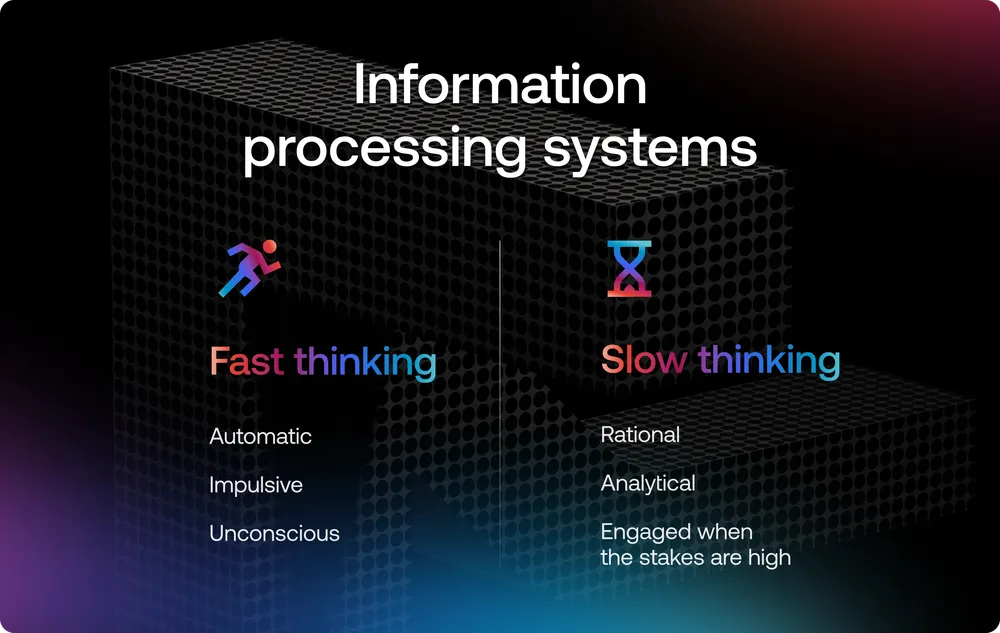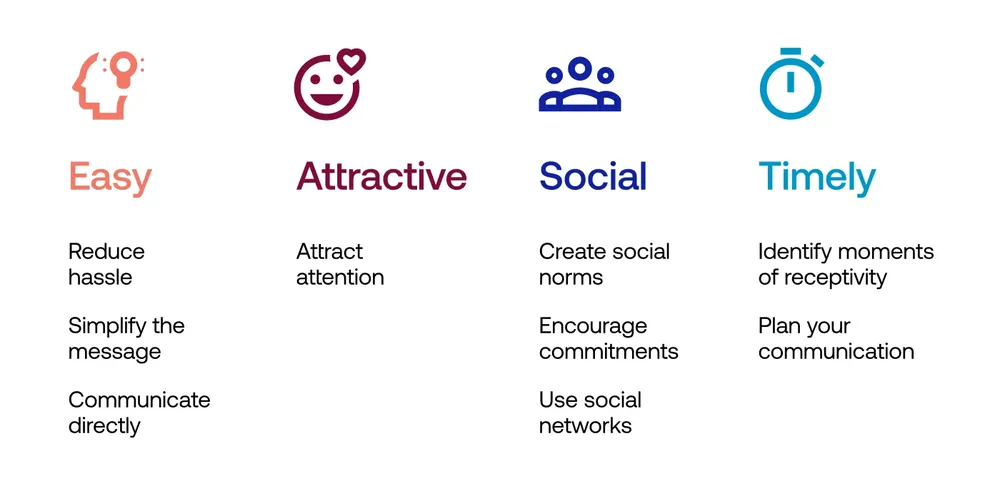
Gallup research shows that companies using behavioral economics insights achieve an 85% higher sales growth and a 25% higher profit margin compared to organizations that don’t employ these tactics.
The ability to understand human behavior, emotions, and contexts when designing processes allows for better customization of services, products, and offerings. It also makes it possible to create a communication strategy based on what people value and how they actually act.
“Thinking is to humans as swimming is to cats; they can do it, but they’d prefer not to,” quipped Daniel Kahneman, the Nobel Prize winner in 2002. When making decisions, we aren't rational beings that always weigh the pros and cons, calculate costs, and compute the value of lost benefits.
Instead, our memory is fallible, we’re influenced by context or emotions, and we like to cut corners. Homo economicus? Forget about it.
There’s the so-called theory of two information processing systems: System 1 – “fast thinking” and System 2 – “slow thinking.” The first one applies to 90% of the decisions we make.
It's automatic, impulsive, and unconscious, so it doesn't care about the consequences of our choices and doesn't easily change its mind. System 2, however, is where rational and analytical thinking reigns supreme, and humans typically engage it when the stakes are high.

Buying a car or a house? That's when System 2 comes into play. In such situations, it's essential to take advantage of product features, comparisons, and education when communicating with consumers. But for most everyday purchases, it's all about the form of communication – it should be attractive, emotional, distinctive, and, often, even funny.
The fact that people are irrational and make quick, impulsive decisions can be attributed to four main reasons:
To save resources, people cut corners and use strategies called heuristics to swiftly handle tasks and decision-making. There are hundreds of these heuristics identified, and they’re shared among all human beings as a species. Gaining a deeper understanding of these mechanisms helps us comprehend how people make various decisions, including purchasing ones.
People tend to attribute disproportionately greater value to things they have created themselves, regardless of how good or bad the end result is. Experiments have shown that consumers rate the taste of a burger more positively (7/10) if they have assembled it themselves, compared to an identical one served ready-made (4/10). They’re also willing to pay more for the self-prepared burger.

People have a tendency to focus on themselves and attribute more importance and agency to themselves than to others. This is particularly evident when analyzing the so-called cocktail party effect, which is the ability to hear one's own name in a crowd, even if someone isn’t speaking to us or about us. Companies leverage this effect by personalizing products and services or by simply communicating that something is “ours” (e.g., “See dresses in your size”).
This effect is based on associations, often unconscious, triggered by stimuli that may be unrelated to a specific situation. Research conducted by behavioral economists has shown that if vegetables and fruits are placed near the store entrance, consumers are likely to buy more of them compared to when they reach the shelves in other parts of the store.
Moreover, consumers who see fresh vegetables and fruits in their shopping baskets are more likely to buy unhealthy snacks as well (after all, they’re getting plenty of healthy items, so they deserve a cheat meal). That’s not the end. Our irrational human brains make us think that a bank employee wearing a tie is more competent than an employee without a tie. Consequently, we’re more willing to discuss risky investment options with the first specialist.

People are more likely to act when faced with the fear of losing something rather than the prospect of gaining something. The Australian airline Qantas, after deciding to no longer serve unappetizing sandwiches (which were objectively disliked and received poor ratings from customers), experienced a notable decline in satisfaction ratings and achieved their lowest-ever Net Promoter Score (NPS).
Surprisingly, the absence of those universally disliked sandwiches caused customers to form negative opinions about the company’s services, flight punctuality, and various other aspects that had no direct connection to the snacks.
People have a tendency to follow others in their footsteps, especially when they don't know what to think or how to behave. In 1994, when Red Bull decided to introduce their energy drink to the market, they took advantage of this effect by filling trash cans in London with empty beverage cans. The full trash cans and the fact that DJs were drinking the new product (receiving it for free) made it easy to infer that it was popular.
Today, we can observe similar strategies when looking at online stores and notifications informing potential buyers how many people are currently viewing a particular item or have just purchased it.
People have a tendency to favor their own social group and strongly identify with it, even if the group has been made up, or it’s not objectively clear if they truly belong to it. One hotel conducted research to find a way to reduce towel exchange requests.
When the hotel communicated the standard message about saving water and energy, only 16% of guests decided not to exchange their towels. But when a new message was introduced, stating that 75% of guests in a particular room had already reused their towels, an impressive 44% of participants adjusted their behavior accordingly. They started to identify themselves as part of the group, even though it might sound a bit abstract.
These are just a few mechanisms that illustrate how consumers make decisions. As these tactics are so universal, paying attention to behavioral economics can change the way services, products, and communication strategies are designed.
If you want consumers to make decisions really quickly, you shouldn’t disrupt their natural rhythm. Poor design provokes thought! But, there are certain situations when people need to be more rational, and proper design can also help you achieve the goal. For example, making someone feel watched will trigger that person to be more careful and avoid making impulsive decisions.

The Behavioral Insights Team from the United Kingdom has developed the EAST model, which can serve as an excellent guide for anyone responsible for consumer communication. It’s especially useful when combined with the knowledge about cognitive biases and heuristics used by people.
Working with the mechanics and tactics of behavioral economics requires a structured approach, in which: